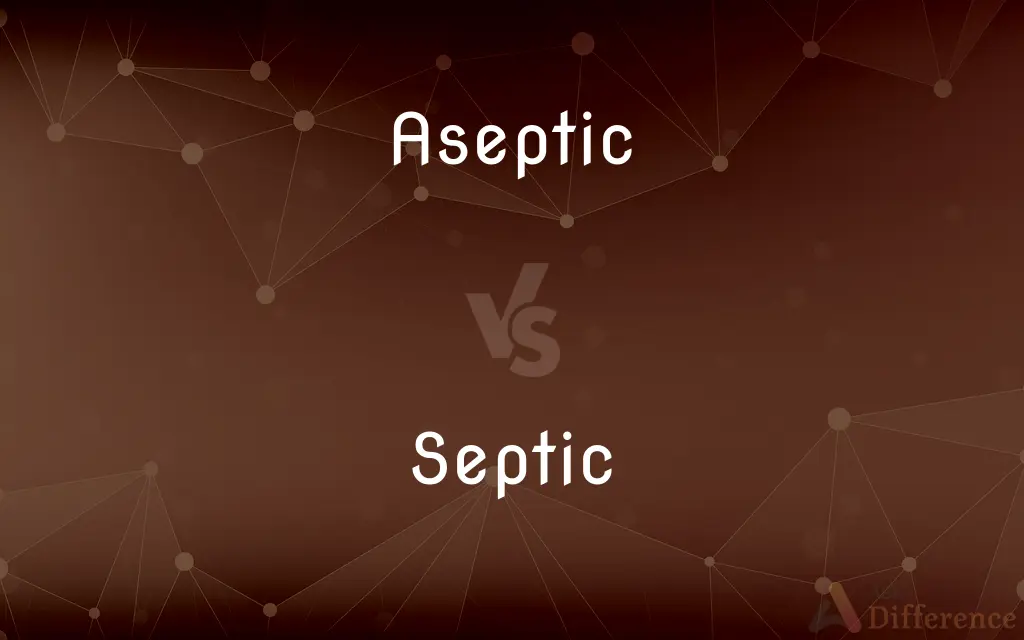Aseptic vs. Septic — What's the Difference?
By Tayyaba Rehman & Maham Liaqat — Updated on March 15, 2024
Aseptic involves sterile conditions to prevent contamination, while septic refers to infection presence, often with harmful bacteria.

Difference Between Aseptic and Septic
Table of Contents
ADVERTISEMENT
Key Differences
Aseptic techniques are employed to create and maintain environments free from microbial contamination, crucial in medical procedures and food production to ensure safety and prevent infections. These methods include sterilization of instruments, use of disinfectants, and maintenance of clean environments. On the other hand, septic conditions arise when an environment is contaminated with harmful bacteria or other microorganisms, leading to infection. This is often seen in medical contexts, such as septic wounds or sepsis, a severe condition resulting from the body's response to infection.
In terms of application, aseptic processes are widely used in surgeries, pharmaceutical manufacturing, and food packaging to ensure that products remain free from microbial contamination. This involves rigorous protocols to maintain cleanliness and sterilization. Whereas, septic conditions are typically associated with poor sanitation, compromised sterile techniques, or the failure of aseptic measures, leading to the proliferation of bacteria and potential health risks.
The goal of aseptic techniques is to protect against infection by ensuring that pathogens are not introduced to vulnerable sites, such as open wounds or sterile products. This requires careful practice and adherence to strict guidelines. Conversely, when septic conditions occur, the focus shifts to treating the infection, which may involve the use of antibiotics, cleaning of the infected area, and sometimes surgical intervention to remove infected tissues.
Aseptic and septic also differ in the environments where they are relevant. Aseptic conditions are essential in controlled environments such as operating rooms, laboratories, and food processing areas where sterility is paramount. In contrast, septic conditions can arise in various settings, often due to breaches in hygiene or failures in maintaining aseptic conditions, and can lead to significant health issues if not addressed promptly.
Understanding the distinction between aseptic and septic is crucial in various fields, particularly in healthcare and food safety, where the prevention of infection and contamination is a primary concern. By implementing aseptic techniques, professionals can significantly reduce the risk of septic conditions and the associated complications.
ADVERTISEMENT
Comparison Chart
Definition
Involves methods to maintain a sterile environment free from contamination.
Refers to the presence of infection, often caused by bacteria.
Application
Used in medical procedures, pharmaceutical manufacturing, and food packaging to prevent microbial contamination.
Associated with conditions arising from contamination, such as wounds or systemic infections.
Goal
To prevent the introduction of pathogens and protect against infection.
To treat and manage infections caused by the presence of harmful microorganisms.
Environment
Required in controlled settings like operating rooms and laboratories.
Can occur in various settings, often due to breaches in hygiene or sterility.
Healthcare Focus
Emphasizes the prevention of infection through sterility and clean practices.
Focuses on treating and managing infections resulting from contamination.
Compare with Definitions
Aseptic
A technique designed to prevent contamination from microorganisms.
Aseptic packaging ensures the milk remains free from bacteria.
Septic
Relating to or resulting from the presence of pathogens.
The wound became septic, necessitating immediate medical attention.
Aseptic
Pertaining to an environment or procedure that is free of contamination.
The surgery was performed under aseptic conditions to avoid infection.
Septic
Describing an infection or its toxic effects.
Septic shock is a serious condition that can lead to organ failure.
Aseptic
Involves practices aimed at maintaining sterility.
Nurses must follow aseptic techniques when inserting a catheter.
Septic
Pertaining to conditions that promote microbial contamination.
The septic tank needs regular maintenance to prevent environmental contamination.
Aseptic
Methods used to ensure products or environments are germ-free.
The lab maintains aseptic conditions to prevent sample contamination.
Septic
Involving or relating to the systemic inflammatory response to infection.
The patient's septic state required intensive care and antibiotic treatment.
Aseptic
Relating to the absence of bacteria, viruses, and other microorganisms.
Aseptic processing involves high temperatures to sterilize food products.
Septic
Associated with the decomposition or putrefaction by bacteria.
The septic smell indicated a serious issue with the waste disposal system.
Aseptic
Free from contamination caused by harmful bacteria, viruses, or other microorganisms; surgically sterile or sterilized.
Septic
(chiefly of a wound or a part of the body) infected with bacteria
His feet had gone septic
Aseptic
Free of pathogenic microorganisms
Aseptic surgical instruments.
Septic
Denoting a drainage system incorporating a septic tank.
Aseptic
Using methods intending to exclude pathogenic microorganisms
Aseptic surgical techniques.
Septic
A drainage system incorporating a septic tank.
Aseptic
Lacking animation or emotion
An aseptic smile.
Septic
Of, relating to, having the nature of, or affected by sepsis.
Aseptic
(medicine) Used to protect against infection by disease-causing microbes.
Pharmaceuticals are packaged using aseptic techniques.
Septic
Causing sepsis; putrefactive.
Aseptic
(food industry) pasteurised.
Septic
Of or pertaining to sepsis.
Aseptic
Not liable to putrefaction; nonputrescent.
Septic
Causing sepsis or putrefaction.
Aseptic
Free from pathogenic microorganisms; sterile; as, aseptic operating conditions.
Septic
Of or pertaining to sewage or the disposal of sewage.
Septic tank; septic system
Aseptic
Lacking emotion, human warmth, or excitement.
Septic
(mathematics) Of the seventh degree or order.
Aseptic
An aseptic substance.
Septic
A substance that causes sepsis or putrefaction.
Aseptic
Free of or using methods to keep free of pathological microorganisms;
A sterile operating area
Aseptic surgical instruments
Aseptic surgical techniques
Septic
A septic tank; a system for the disposal of sewage into a septic tank, a septic system.
Septic
(mathematics) A mathematical object (function, curve, surface, etc.) of degree seven. Category:en:Polynomials Category:en:Curves Category:en:Surfaces
Septic
An American, a Yank.
Septic
Of the seventh degree or order.
Septic
Having power to promote putrefaction.
Septic
A substance that promotes putrefaction.
Septic
Containing or resulting from disease-causing organisms;
A septic sore throat
A septic environment
Septic sewage
Septic
Of or relating to or caused by putrefaction;
The septic action occurs at the bottom of the septic tank
Common Curiosities
Can aseptic conditions be achieved in everyday environments?
While it's challenging to achieve complete aseptic conditions in everyday environments, certain practices like proper sterilization and hygiene can significantly reduce contamination risks.
What causes septic conditions?
Septic conditions are caused by the presence and proliferation of harmful microorganisms, often due to inadequate sterilization, poor hygiene, or compromised immune systems.
What is aseptic technique?
Aseptic technique involves practices to maintain sterility and prevent microbial contamination during medical procedures or in the production of sterile products.
Why is aseptic technique important in surgeries?
Aseptic technique is crucial in surgeries to prevent post-operative infections by ensuring that no microbial contaminants are introduced into open wounds or sterile areas.
Can septic conditions lead to systemic infections?
Yes, septic conditions can escalate into systemic infections like sepsis, where the body's response to infection can affect multiple organ systems.
How do hospitals ensure aseptic conditions?
Hospitals ensure aseptic conditions through strict sterilization protocols, use of sterile equipment, proper hand hygiene, and environmental controls.
How do aseptic and septic conditions differ?
Aseptic conditions are free from contamination and aim to prevent infection, while septic conditions are characterized by the presence of infection and harmful microorganisms.
How do aseptic packaging techniques benefit food safety?
Aseptic packaging techniques keep food products sterile and safe from microbial contamination, extending shelf life and preserving quality without the need for preservatives.
How can septic conditions be treated?
Septic conditions are typically treated with antibiotics to combat bacterial infections, along with other supportive measures like fluid replacement and, in severe cases, surgical intervention.
Is it possible to recover from septic conditions?
Yes, with prompt and appropriate treatment, it's possible to recover from septic conditions, although the prognosis varies based on the severity of the infection and the patient's overall health.
Are aseptic techniques only relevant in medical fields?
While particularly crucial in medical fields, aseptic techniques are also important in food processing, pharmaceutical manufacturing, and any other industry where sterility is a concern.
How do aseptic techniques contribute to antibiotic resistance?
Aseptic techniques do not directly contribute to antibiotic resistance; rather, they help reduce the need for antibiotics by preventing infections, thereby potentially mitigating the development of resistance.
What role do aseptic techniques play in biotechnology?
In biotechnology, aseptic techniques are essential for experiments and production processes that require controlled environments to prevent contamination and ensure the integrity of samples and products.
Share Your Discovery

Previous Comparison
Wheat vs. Maize
Next Comparison
Entity vs. IdentityAuthor Spotlight
Written by
Tayyaba RehmanTayyaba Rehman is a distinguished writer, currently serving as a primary contributor to askdifference.com. As a researcher in semantics and etymology, Tayyaba's passion for the complexity of languages and their distinctions has found a perfect home on the platform. Tayyaba delves into the intricacies of language, distinguishing between commonly confused words and phrases, thereby providing clarity for readers worldwide.
Co-written by
Maham Liaqat















































